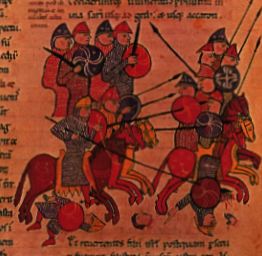|
|||
|
Philatelia.Net / The literature / Plots / The directory «Plots»«The Song of the Cid» («Poema De Mio Cid»)«El Cantar del Mio Cid» is the oldest preserved Spanish cantar de gesta. Formerly, it was transmitted only orally, but in 1142 it was written down by a certain Per Abbat. This copy is held as part of a 14th century codex in the National Library in Madrid. However, it is incomplete. The first page and two others in the middle are missing. It is written in medieval Spanish, the ancestor of modern Spanish. Its current title is a modern invention by Ramón Menéndez Pidal; its original title is unknown. Some call it «El Poema del Cid» on the grounds that it is not a cantar but a poem made up of three cantares. The title has been translated into English as «The Lay of the Cid» and «The Song of the Cid». Some English translations include the verse translation of W.S. Merwin and prose translation of Rita Hamilton and Janet Perry. Based on a true story, it tells of a Spanish hero El Cid or El Campeador, whose true name was Rodrigo (or Ruy) Díaz de Vivar, during the Reconquista, or reconquest of Spain from the Moors. El Cid married the cousin of King Alfonso VI, Doña Ximena, but for obscure reasons (according to the story, he made the king swear at Santa Gadea he had not ordered the fratricide of his own brother), he fell into the disfavor of the king and had to leave his home country Castile. To regain his honor, he participated in the battles against the Moorish armies and conquered Valencia. By these heroic acts he regained the confidence of the king and his honor was restored. His two daughters then married the infantes (princes) of Navarre and Aragon. Through the marriages of his daughters, the Cid began the unification of Spain. Unlike other European medieval epics, the tone is realist[1]. There is no magic, even the apparition of archangel Gabriel (verses 404–410) happens in a dream. However it also departs from historic truth: for example, there is no mention of his son, his daughters were not named Elvira and Sol and they did not become queens. It consists of more than 3700 verses of usually 14 through 16 syllables, each with a cesure between the hemistiches. The rhyme is assonant. The entire work is conventionally divided into three parts: El Cid has to leave Castile and fights with the Moorish king of Zaragoza until he gets to Valencia. The infantes of Carrión offend and abandon their wives. Once more, El Cid has to gain his honor back, so he asks the court of Toledo for justice. Then he remarries his two daughters to the infantes (sons of the kings) of Navarre and Aragon. Through the marriages of his daughters, the Cid begins the unification of Spain. The whole work is anonymous. There was a theory to which few subscribe that it was composed by two people. That theory is not supported any more. By virtue of the analysis of numerous aspects of the conserved text it can be demonstrated that it belongs to a cultured Dona Elvira author, with precise knowledge of the law in effect by the end of the 12th century and principles of the 13th, and that he knew the zone bordering to Burgos. The language used is that of a cultured author, a lawyer who worked for some chancellery or at least as a notary of some nobleman or monastery, since he knows accurately the legal and administrative language with technical precision, and he dominates several registries, among them, the proper style of the medieval cantares de gesta. Sao Tome e Principe, 2008, Films of Charlton Heston Spain, 1962, Statue of El Cid in Sevilla Spain, 1962, The tomb of El Cid in Burgos Cathedral Spain, 1962, Oath-talking ceremony Spain, 2000, Death of El Cid Advertising: Îïèñàíèå ãàçîïîðøíåâûå ýëåêòðîñòàíöèè àðåíäà íà ñàéòå. |
|||
© 2003-2024 Dmitry Karasyuk. Idea, preparation, drawing up
|

